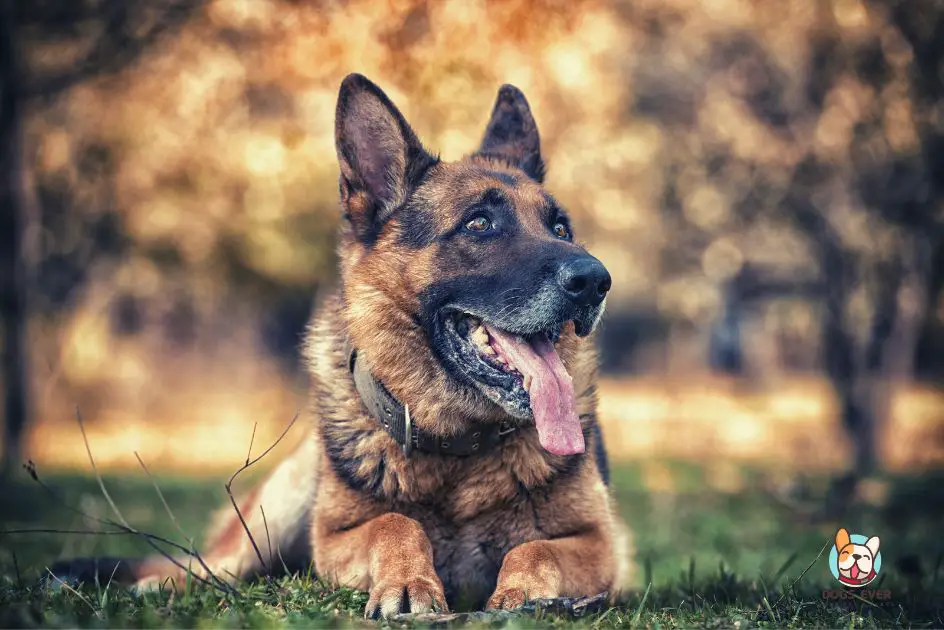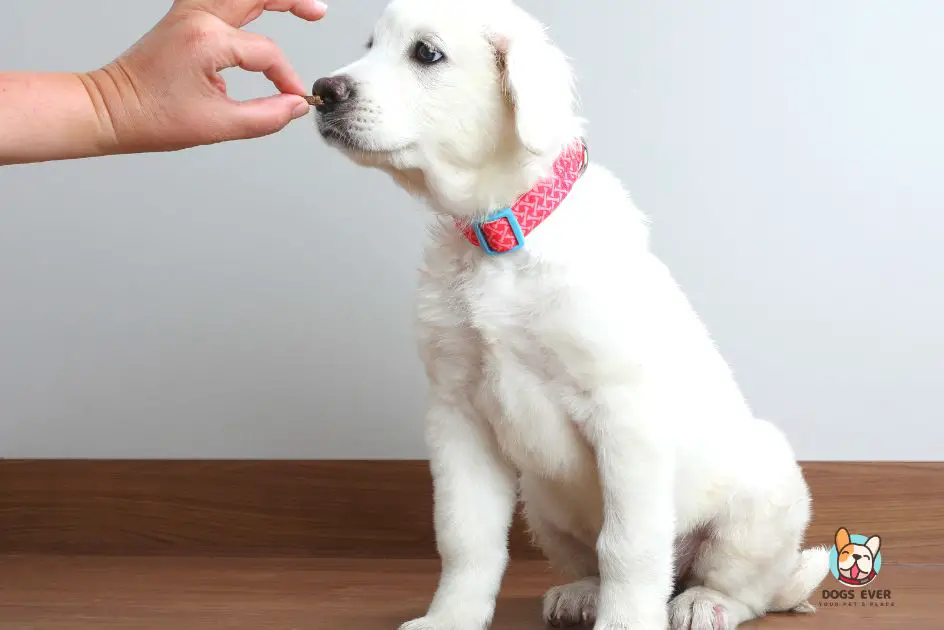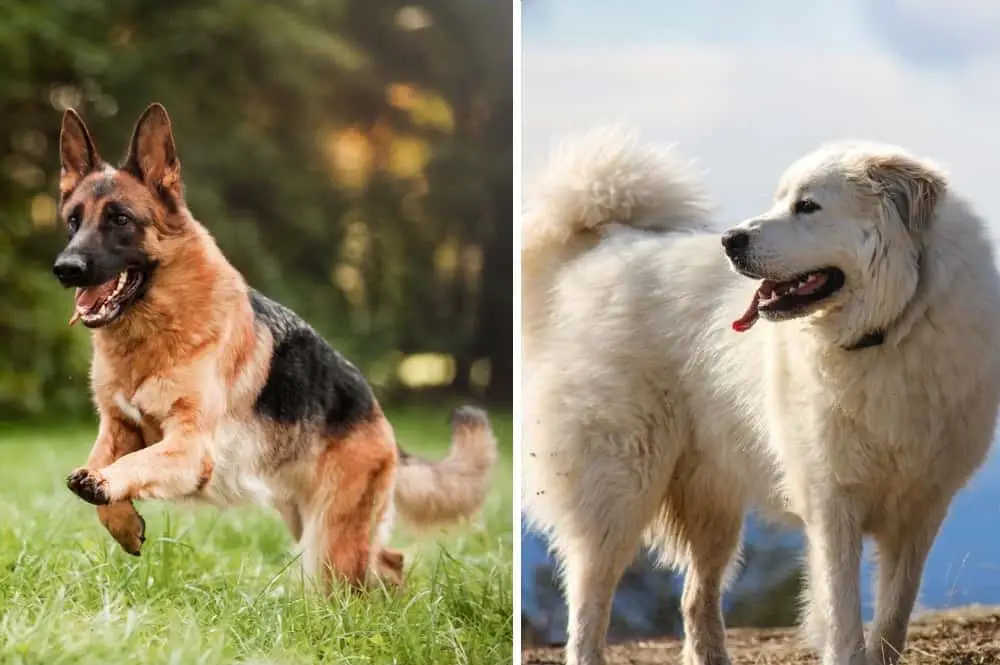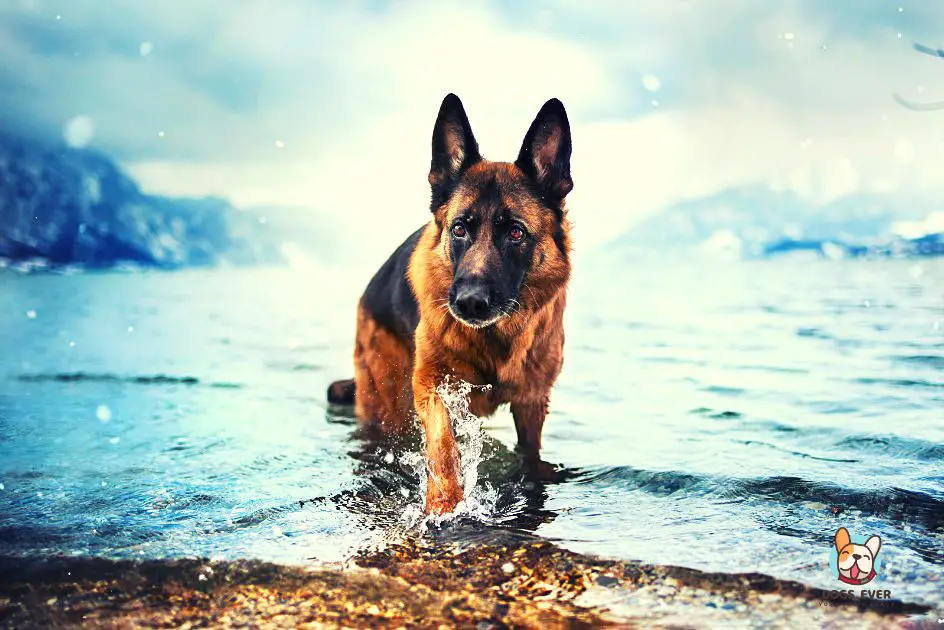German Shepherd Dog vs Great Pyrenees Size Comparison
When comparing German Shepherd Dogs and Great Pyrenees in terms of size, there is a notable difference. German Shepherds are typically smaller and more lightweight than Great Pyrenees, with males reaching heights of up to 30 inches at the shoulder and weights of up to 120 pounds.
On the other hand, German Shepherds tend to be smaller, reaching heights of up to 25 inches at the shoulder and weights of up to 90 pounds.
Interestingly, despite their size differences, both dogs have strong protective instincts and make wonderful family pets. As long as they receive adequate exercise and attention from their owners, both breeds will make loyal companions for many years to come.
What’s Their Behavior and Temperament Like?
The temperament of a dog and behavior around people and other dogs is key to choosing the right pet for you. While most characteristics are defined by how you teach them and train them, it’s true that each breed has certain tendencies. So let’s take a look at these two.
The perfect family dog?
Both the Great Pyrenees and the German Sheperds are great family dogs. They have a friendly personality will turn them into family members in the blink of an eye.
They are very friendly and affectionate with kids, although the German Shepherd might be slightly better on this regard. However, both of them are perfectly ok.
With that being said, please also make sure your kids are a good fit for dogs. Educating kids and helping them understand that the dogs are animals that need and are worthy of love makes a whole lot of a difference. These two breeds are very patient but they will definitely defend themselves if they feel attacked by a kid who’s trying to harm them physically.

How about their guarding behavior?
Both dog breeds are protective of their family, although the Sheppie might take a more active role when strangers surround the house.
The German Shepherd is known for its strong guarding instincts, making it a popular breed of dog for many families looking for a loyal companion. They are alert and attentive, easily recognizing potential threats and responding quickly to protect their owners or property.
German Shepherds often display passive and aggressive behaviors when protecting their territory, such as barking, growling, lunging, or even biting if necessary. Their loyalty and courage make them excellent guard dogs, but they can also be loving family companions with proper training and socialization.
With an innate desire to please their owners, German Shepherds can be trained to differentiate between friends and strangers while providing the best protection possible. They are very easy to train, and you can do it yourself.
The Great Pyrenees is a loyal, protective breed of dog that makes an excellent guard dog. They are known for their guarding behavior, which includes alerting owners to potential dangers and keeping strangers away from the property.
They have a loud bark and will patrol the property’s perimeter to protect against intruders or animals. They are also very territorial and will not tolerate intrusions on their territory.
Additionally, they are known for their calm, gentle nature with family members and those they trust, making them a great companion as well as a guardian.
Behavior with other dogs
German Shepherds and Great Pyrenees are two breeds of dogs that have very different personalities when it comes to interacting with other dogs. The Sherman Sheperd is generally better than the Great Pyrenees with other dogs.
German Shepherds are more outgoing, friendly, and playful around other dogs. They are often eager to make new friends and happily join in a game of fetch or tag with another pup.
Great Pyrenees, on the other hand, can be more aloof and independent. While they may not be as outgoing as German Shepherds, they are still generally good-natured around other dogs, but they may prefer to keep their distance.
Both breeds tend to be loyal and protective of their owners and will alert them if an unfamiliar dog is approaching their territory.
German Shepherd vs Great Pyrenees Lifespan Compared

We all know our beloved dogs live less than humans do. That’s why understanding their lifespan can be a deciding factor
Both breeds can live up to 12 years on average. However, the German Shepherd tends to have a longer life expectancy than the Great Pyrenees. The Great Pyrenees typically has a maximum age of 10-12 years, while the German Shepherds can live up to 12-14 years.
Furthermore, due to their large size and active lifestyle, both breeds may experience health issues that could reduce their lifetime if not properly cared for.
In conclusion, although both breeds are very similar in this aspect, the German Shepherd is likely to outlive its counterpart by a few years if given proper care and nourishment.
Great Pyrenees vs German Shepherd Dog adaptability
Let’s talk about these two breeds in terms of adaptability to the environment. More specifically, the place they live and the weather conditions.
Great Pyrenees should not live in apartments
As a large, powerful breed of dog, the Great Pyrenees require substantial space to run and exercise. This breed should not live in apartments due to their size, strength and high energy levels.
This dog needs plenty of outdoor activities such as running, walking and playing fetch, so an apartment may not be able to accommodate them adequately. They are better suited for a house with a large yard or large open spaces where they can expend their energy and roam freely.
Too much confinement can lead to behavioral problems like barking, chewing and digging. Additionally, Great Pyrenees have thick fur coats that require regular brushing and can quickly shed throughout the home if living in an enclosed space such as an apartment. Therefore, it is best for this breed to live in a larger environment with lots of room for exercise and playtime.
German Shepherds can live in apartments
Despite their size and potential for high energy, they can make great companions for apartment living. When properly trained, exercised, and socialized, German Shepherds can be happy in any sized home.
They thrive with regular walks and activities such as agility training or obedience classes. They require a lot of mental stimulation, which can be provided through activities like puzzle toys and learning new tricks. With an owner that can provide a consistent routine and enough activity,
German Shepherds can easily adjust to life in an apartment setting. As long as their needs are met, they will remain loyal, loving family members regardless of their living situation.
The Great Pyrenees and the German Shepherd in Cold Weather
The Great Pyrenees has a large, thick coat and was bred to herd and guard livestock in the snowy mountaintops of the Pyrenees. The thick coat provides great insulation from the cold while their size gives them a natural advantage over smaller animals. The German Shepherd is an intelligent and loyal breed with a double coat, which also provides great warmth.
Their strong size and powerful build make them perfect for outdoor activities in cold weather, such as running or playing fetch in the snow. Both breeds are incredibly hardy and have many of the same traits that make them well-suited to living in colder climates. They’re both smart enough to learn commands quickly, and they’re both loyal companions who will go out of their way to protect their owners from danger.
The Great Pyrenees and the German Shepherd in Warm Weather
Warm weather is not great for the Great Pyrenees or German Shepherd, but they can tolerate it if you take some caution. Make sure they have access to plenty of water and shade, as well as regular breaks from the sun. You should also avoid exercising them in extreme heat, as their thick double coats can cause them to overheat easily. Also, trimming their coat in summer can help keep them cool.
Cost of Owning a German Shepherd and Great Pyrenees
The cost of owning a German Shepherd or Great Pyrenees can vary greatly depending on the breed and age of the dog, as well as the location where you purchase or adopt it. Generally, when purchasing or adopting, you can expect to spend anywhere from $800 to $1,500 for a German Shepherd and between $1,200 to $2,000 for a Great Pyrenees.
This does not include any additional costs that may arise, such as food, medical expenses, grooming supplies, toys, etc. In addition to these costs, you will also need to factor in the time commitment involved with taking care of these breeds—both require regular exercise and mental stimulation.
It is important to consider all of these factors before making your decision so that you are able to provide your pet with the best possible life.
Great Pyrenees and German Shepherd health issues
These big dogs may experience some health issues, especially around the last years of their lives. Let’s see what you might face if the time comes.
Potential Health Problems of the Great Pyrenees
The Great Pyrenees has some potential health problems due to their large size and breed-specific traits. Some of the most common issues include elbow and hip dysplasia, eye abnormalities, and joint problems. Other potential concerns include bloat, heart and respiratory conditions, allergies, skin conditions, and thyroid issues.
To help prevent or minimize these risks, owners should ensure their pet receives regular veterinary checkups and has plenty of exercises to keep them healthy and active. They should also maintain a nutritious diet with proper nutrition to promote overall well-being. With proper care from a qualified vet, the Great Pyrenees can live a long and happy life in good health.
Potential Health Problems of the German Shepherd
The German Shepherd can also be prone to certain health problems. Common issues include elbow and hip dysplasia, which are inherited disorders of the joints; Von Willebrand’s disease, a hereditary bleeding disorder; and bloat, a stomach condition that can be deadly if not treated in time. Other potential problems include allergies, thyroid issues, and degenerative myelopathy.
Owners of this breed need to monitor their pet closely for any signs of illness or distress, as early detection can greatly improve the outcome. Regular vet check-ups and screenings are recommended to catch any potential health issues before they become serious.
Trainability – Can these breeds be trained the same?

Training a German Shepherd and the Great Pyrenees can be quite different experiences. German Shepherds tend to be more active and energetic, requiring more activity and exercise than the Great Pyrenees. German Shepherds also have a higher intelligence level, making them easier to train in obedience, agility, and other activities.
On the other hand, the Great Pyrenees are known for their laid-back personalities and may take longer to train. They don’t require as much activity as the German Shepherd but do need consistent reinforcement of commands to learn properly.
Training these breeds requires patience, consistency, and lots of love!
Great Pyrenees vs German Shepherd Grooming Needs
Grooming needs for both the Great Pyrenees and the German Shepherd are similar, but in general, the bigger pup needs the most care.
The Great Pyrenees has a much thicker coat than the German Shepherd, so they require more frequent brushing and combing to keep their fur from matting. This breed also needs regular baths because of its thick coats.
The German Shepherd, on the other hand, has a thinner coat that does not need as much brushing or combing. While it still needs occasional baths, it can usually go longer between them than the Great Pyrenees.
Both breeds have relatively short nails that should be trimmed regularly to prevent overgrowth and discomfort while walking.
German Shepherd Dog or Great Pyrenees – Which one should you get?
Both breeds are amazing for your family, they are especially awesome around children and can become your most beloved and adorable puppy if you wish to adopt either. If you’re a less experienced dog owner, generally have less space available and you want a loyal and active companion, then a working dog class like the German Shepherd is the best choice. On the contrary, if you have more space available to keep your dog active, have plenty of time to play and generally enjoy a more calm and (sometimes) lazy attitude, then the Great Pyrenees will be your best fit.
Frequently Asked Questions
Do German Shepherd Dog and Great Pyrenees need a lot of physical activity?
German Shepherd Dogs and Great Pyrenees both need a lot of physical activity in order to stay healthy and happy. These two breeds are very active, and they thrive when they get plenty of exercise.
German Shepherds are known for their intelligence and agility, making them excellent running partners or even agility course participants.
Great Pyrenees, on the other hand, love long walks and hikes, making them great companions for outdoor activities.
Both breeds need a minimum of 1-2 hours of vigorous exercise each day, such as running or playing fetch. If you are unable to give these breeds enough time outside each day, then it is important to make sure they have access to plenty of toys and activities that can keep them entertained indoors.
Are Great Pyrenees as smart as German Shepherd?
The Great Pyrenees and German Shepherd are both highly intelligent and trainable breeds. In terms of intelligence, the two breeds are likely equally smart; however, their methods of learning may differ. The Great Pyrenees is known for being loyal and obedient but also independent-minded. For this reason, they often require a different approach to training than other breeds.
On the other hand, German Shepherds are known to be eager to please and learn commands quickly. Therefore, when training either breed, patience and consistency is key in order to ensure successful development. Ultimately, while both breeds have similar levels of intelligence, they may require different approaches when it comes to training and behavior modification.
Do German Shepherds and Great Pyrenees get along?
German Shepherds and Great Pyrenees can get along very well with each other if they are properly introduced and socialized. These two breeds have different temperaments, but with the right training and socialization, they can learn to respect each other and even become friends. German Shepherds are known for their intelligence, courage, loyalty and work ethic while Great Pyrenees possess a calmer demeanor. It is important to give both breeds enough exercise and play time together so that they can bond over activities.
Does the Great Pyrenees breed eat more than the German Shepherd breed?
The answer to the question of whether the Great Pyrenees breed eats more than the German Shepherd breed depends on several factors. First, it depends on the individual dog’s dietary needs and activity level. A working or active Great Pyrenees may need a higher caloric intake than a less active German Shepherd.
Second, it depends on the quality of food being fed. Higher-quality foods have fewer fillers and are more nutrient dense, so a higher amount may be necessary for adequate nutrition for a Great Pyrenees over a German Shepherd. Finally, it also depends on how much of the food is actually consumed by each breed.
Some dogs are picky eaters and may not finish their meals while others will clean their bowl every time they eat.
Overall, unless there are specific dietary needs or activity levels that require more food for one breed over another, both breeds should typically consume similar amounts of food.
How many puppies can Great Pyrenees and German Shepherd have?
The Great Pyrenees and German Shepherd are both large breeds of dogs, so it is no surprise that they can have quite a large litter size. It is common for a Great Pyrenees to have 6-10 puppies in each litter, with an average litter size of 7 or 8. German Shepherds typically have larger litters with 8-14 puppies per litter and an average of 10 or 11 puppies per litter.
Both breeds can have more than one litter at once due to their strong maternal instinct. However, it is important that the mother dog gets plenty of rest and nutrition in order to provide for her pups. Even though these breeds can have large litters, it is always best to consult with a veterinarian beforehand to ensure a healthy delivery.
Is a Great Pyrenees taller than a German Shepherd?
Yes it is. On average, a Great Pyrenees is about 5 inches taller than a German Shepherd when fully grown into an adult dog.
Is a Great Pyrenees more dangerous than a German Shepherd?
No, it isn’t. None of these breeds are dangerous or have strong attacking instincts unless trained otherwise. Remember that none of these breeds are hunters, so they tend to be more passive than others. They sure bark a lot, but it’s less likely for them to bite.




